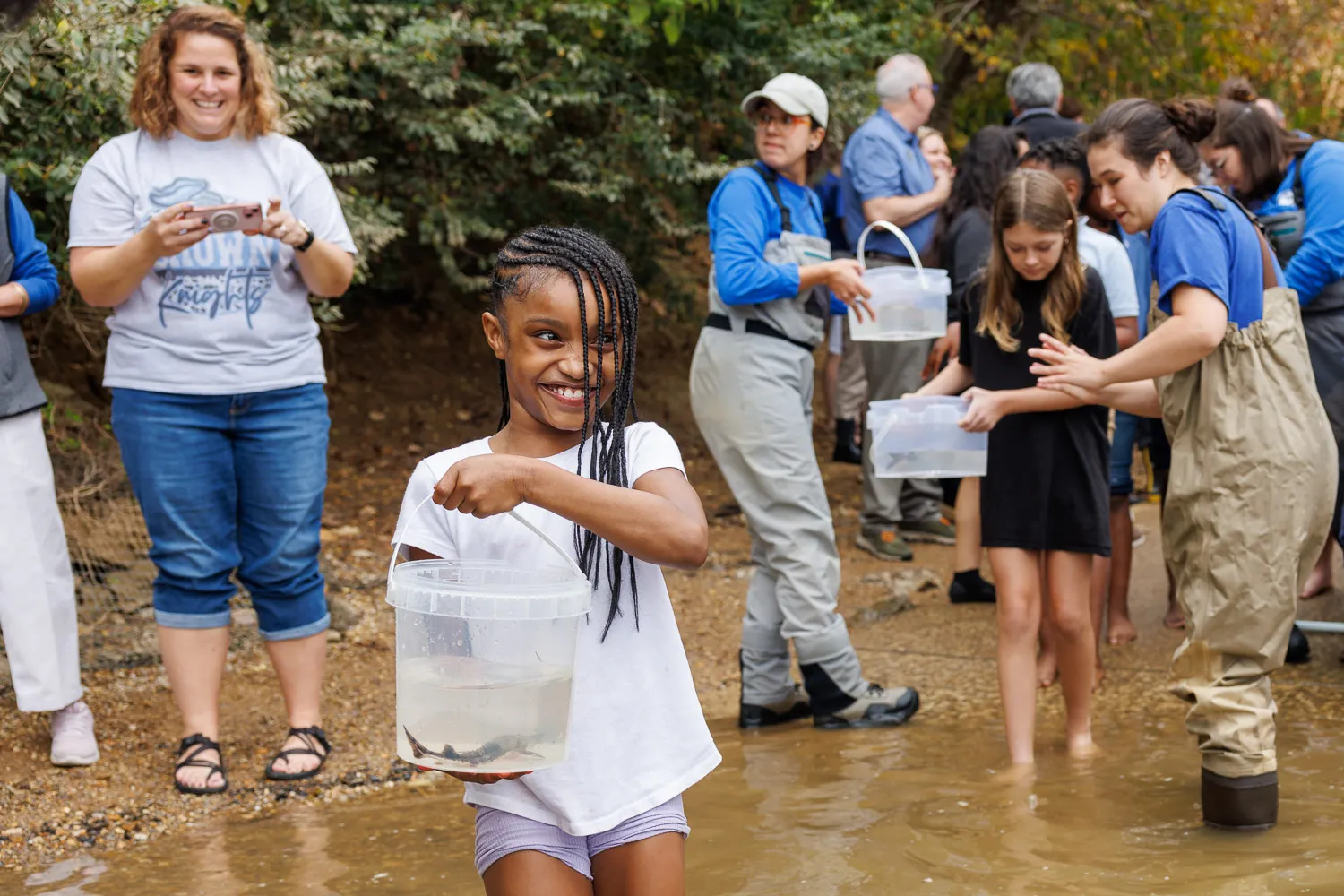Chattanooga, Tenn. (Oct. 30, 2024) – Under slate gray skies laden with clouds, dozens of elementary school students gathered at the edge of the Tennessee River to assist biologists in saving an endangered fish that could potentially outlive not only them but also their grandchildren.
About 50 Brown Academy fifth graders joined scientists from the Tennessee Aquarium Conservation Institute (TNACI) and Tennessee Aquarium educators to reintroduce about 500 state-endangered Lake Sturgeon into the river as it flowed through downtown Chattanooga. Over the course of about an hour, the students and biologists released about 500 juvenile Lake Sturgeon by ones and twos into the water off the boat ramp at Coolidge Park.
Measuring between four and eight inches in length, the fish joined more than 425,000 other Lake Sturgeon raised and released by the Aquarium and its partners into the Tennessee River and Cumberland River watersheds over the last 24 years.
“It’s really amazing to see all of our hard work over the summer to care for these fish coming together in this moment,” said Reintroduction Biologist II Sarah Kate Bailey. “It’s awesome to see the next generation of conservation scientists out here releasing these fish with us.”
Shuffling their feet to avoid stepping on any previously reintroduced fish, the participants waded into the water until it reached about calf height. Carefully bending over, they dipped their buckets into the river, watching — and occasionally cheering — as the brown- and tan-mottled fish glided into the current.
These juvenile Lake Sturgeon represented not only months of care and effort on the part of biologists but also the latest chapter in a restoration effort that began in 1998.
Just 50 years ago, however, a release like this morning’s would have been inconceivable. As recently as the 1970s, Lake Sturgeon had completely disappeared from the Tennessee River thanks to a combination of overfishing, damming of the river, and poor water quality.
By the late ’90s, the river was being better managed, Lake Sturgeon were protected as a state-endangered species, and water quality in the Tennessee River had substantially improved thanks to regulations established by the Clean Water Act of 1973.
At that point, scientists determined the river could once more support a wild Lake Sturgeon population. This spurred the Aquarium and a coalition of federal and non-profit conservation organizations to form the Lake Sturgeon Working Group in 1998.
Leveraging its experience in propagation, the Aquarium began raising annual classes of juveniles hatched from eggs laid by wild sturgeon in Wisconsin’s Wolf River, where the species’ populations have remained healthy. In 2000, the first class of fish raised in human care was introduced into the river.
However, even after 24 years of annual releases totaling almost half a million fish, scientists are still waiting for evidence that the reintroduced Lake Sturgeon have started reproducing independently.
The delay has not been unexpected, though.
An armor-flanked relic of a bygone era, Lake Sturgeon have an impressive natural history dating back to age of the dinosaurs. Adults can reach 300 pounds and more than nine feet in length, and records have shown them to have lifespans in excess of 150 years.
Like many long-lived species, Lake Sturgeon are slow to mature, with females incapable of reproducing until they’re at least 20 years old. With the Lake Sturgeon restoration effort now in its 24th year, the first reintroduced fish have only recently achieved sexual maturity.
Bailey says working alongside students to release these fish reinforces the importance of scientists’ commitment to long-term reintroduction efforts. Someday, she says, the Brown Academy students will hopefully see the successful conclusion to a restoration project that began long before they were born.
“By the time these fifth graders are old enough to enter their careers, we may be seeing Lake Sturgeon successfully re-established in the Tennessee River,” Bailey says. “That would be a huge achievement for this project after we’ve put in so many years of work toward that goal.”
To learn more about Lake Sturgeon, visit tnaqua.org/animal/lake-sturgeon/
Check in on adult Lake Sturgeon living at the Tennessee Aquarium via an always-online webcam at tnaqua.org/live/lake-sturgeon-cam/
